
The insects of the beetle family Chrysomelidae are commonly known as leaf beetles, and include over 37,000 species in more than 2,500 genera, making up one of the largest and most commonly encountered of all beetle families. Numerous subfamilies are recognized, but the precise taxonomy and systematics are likely to change with ongoing research.

Trichocentrum, often abbreviated Trctm in horticulture, is a genus in the orchid family, Orchidaceae. Dancinglady orchid is a common name for plants in this genus. It was described by Stephan Ladislaus Endlicher and Eduard Friedrich Poeppig in 1836. This genus alone makes up the monogeneric Trichocentrum alliance, a quite distinct lineage of the subtribe Oncidiinae.

Loricariidae is the largest family of catfish, with 92 genera and just over 680 species. Loricariids originate from freshwater habitats of Costa Rica, Panama, and tropical and subtropical South America. These fish are noted for the bony plates covering their bodies and their suckermouths. Several genera are sold as "plecos", notably the suckermouth catfish, Hypostomus plecostomus, and are popular as aquarium fish.

The glass frogs are frogs of the amphibian family Centrolenidae. While the general background coloration of most glass frogs is primarily lime green, the abdominal skin of some members of this family is transparent and translucent. The internal viscera, including the heart, liver, and gastrointestinal tract, are visible through the skin, hence the common name is given as glass frog. Glass frogs are arboreal, meaning they mainly live in trees, and only come out for mating season.

Astraptes is the genus of flasher butterflies. They belong to the skipper butterfly subfamily Eudaminae, which was long included with the spread-winged skippers (Pyrginae) as a tribe. They are found in the Nearctic and Neotropical ecozones.

The Eumolpinae are a subfamily of the leaf beetles, or Chrysomelidae. It is one of the largest subfamilies of leaf beetles, including more than 500 genera and 7000 species. They are oval, and convex in form, and measure up to 10 mm in size. Typical coloration for this subfamily of beetles ranges from bright yellow to dark red. Many species are iridescent or brilliantly metallic blue or green in appearance.

The Cassidinae are a subfamily of the leaf beetles, or Chrysomelidae. The antennae arise close to each other and some members have the pronotal and elytral edges extended to the side and covering the legs so as to give them the common name of tortoise beetles. Some members, such as in the tribe Hispini, are notable for the spiny outgrowths to the pronotum and elytra.

Transandinomys bolivaris, also known as the long-whiskered rice rat, is a rodent in the genus Transandinomys. It is found in humid forest from northeastern Honduras to western Ecuador, up to 1,800 m (5,900 ft) above sea level. Since it was first described in 1901 from Ecuador, six scientific names have been introduced for it, but their common identity was not documented until 1998 and the species has long been known under the name Oryzomys bombycinus, described from Panama in 1912. The name Oryzomys bolivaris was used before it was moved to the new genus Transandinomys with Transandinomys talamancae in 2006.

Cryosophila is a genus of medium-sized fan palms that range from central Mexico to northern Colombia. Species in the genus can be readily distinguished from related genera by their distinctive downward-pointing spines on the stem, which are actually modified roots. They are known as the "root spine palms".

The grey-headed tanager is a widely distributed species of small Neotropical bird in the tanager family Thraupidae. It is the only member of the genus Eucometis.

The Cranaidae are a family of neotropical harvestmen within the suborder Laniatores.

Transandinomys is a genus of rodents in the tribe Oryzomyini of family Cricetidae. It includes two species—T. bolivaris and T. talamancae—found in forests from Honduras in Central America south and east to southwestern Ecuador and northwestern Venezuela in northern South America. Until 2006, its members were included in the genus Oryzomys, but phylogenetic analysis showed that they are not closely related to the type species of that genus, and they have therefore been placed in a new genus. They may be most closely related to genera like Hylaeamys and Euryoryzomys, which contain very similar species. Both species of Transandinomys have had eventful taxonomic histories.
Xanthonia is a genus of leaf beetles in the subfamily Eumolpinae. It is distributed in North and Central America, and in East, Southeast and South Asia.

Rhytidochrotinae is a subfamily of grasshoppers from the family Acrididae with 20 genera and 47 species. This group is found from southern Central America to northern South America with most species distributed in montane forests. The highest concentration of species are found on the Pacific coast and in the West Andes of Colombia with 11 genera and 23 species registered. Many are brightly colored in reds, especially males, and most species are apterous.
Thysanomeros is a genus of leaf beetles in the subfamily Eumolpinae. It is found in Costa Rica. The generic name is derived from the Greek thysano ("brush") and meros ("femur").
Cryocolaspis is a genus of leaf beetles in the subfamily Eumolpinae. It contains only one species, Cryocolaspis crinita, which is known from the mountains of central Costa Rica. It was first established by the American entomologist R. Wills Flowers in 2004.
Cayetunya is a genus of leaf beetles in the subfamily Eumolpinae. It is known from Central and South America. It was first described by the Czech entomologist Jan Bechyné in 1958.
Cubispa is a genus of leaf beetles consisting of two species from Central America and the Caribbean. It is classified within the tribe Cubispini, which is placed within either the Eumolpinae or the Cassidinae. Beetles in the genus are wingless, and are associated with cloud forests.
Beltia is a genus of leaf beetles in the subfamily Eumolpinae. It is known from the Neotropical realm. It was first erected by Martin Jacoby in 1881 for a single species from Nicaragua. In 2018, it was redefined to include fourteen new species from Central America and northwestern South America, as well as four species transferred from Colaspoides.
Cubispini is a tribe of leaf beetles from the Neotropical realm. It is classified within either the Eumolpinae or the Cassidinae. It was established by Francisco Monrós in 1954 to contain the genus Cubispa, which was originally placed in the subfamily Hispinae, in the tribe Cephaloleini. A second genus, Lobispa, was described and placed in the tribe by C.L. Staines in 2001.












